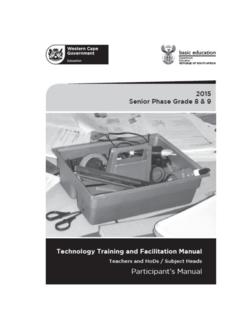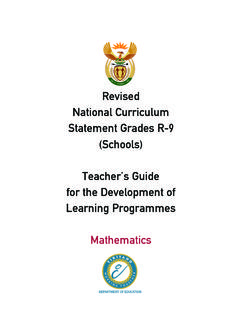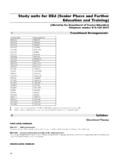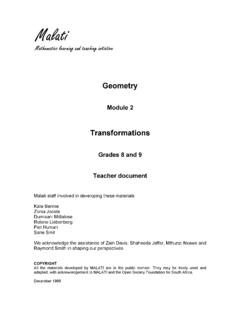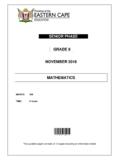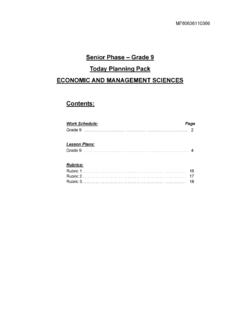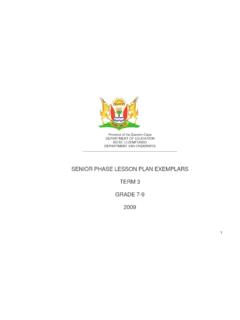Transcription of CORE CURRICULUM PRODUCTS SENIOR PHASE GRADE 7 …
1 core CURRICULUM PRODUCTS SENIOR PHASE GRADE 7 (Content of additional subjects available on request) MATHEMATICS (PACEs 1073 1084) The student: Reads, writes, and works with whole and mixed numbers, integers, and proper and improper fractions. Learns the proper mathematical terminology dividend, multiplicand, product , simplify, minuend, quotient, numerator, and denominator; changes fractions and decimals to percentages; finds the number when a percentage is known; finds the mean, mode, median, range, and rank; and interprets graphs, stem and leaf plots, and box and whisker plots.
2 Is introduced to business and consumer arithmetic profit and loss, commission, discounts, bills and receipts, and invoices with discounts; ratios, proportions, and percentages. Reviews geometric concepts and finds perimeter, circumference, and surface area. Learns Biblical principles of finance, budgeting, saving, investing, and bank services. Reviews basic geometry concepts and symbols and uses a protractor and compass to find perimeter and area of shapes and solids. Is introduced to equations variable, sets, and set notation; vocabulary; symbols; and word problems.
3 ENGLISH LEARNING MATERIALS ENGLISH (PACEs 1073 1084) The student: Identifies, reviews, and diagrams simple, compound, and complex sentence patterns. Reviews eight parts of speech and studies prepositions, conjunctions, and interjections. Is introduced to infinitives and gerunds. Reviews principal parts of regular and irregular verbs perfect tenses; conjugation of all six tenses; progressive verb forms; transitive and intransitive verbs; and subject-verb agreement. Increases noun study exact, compound, collective, plural, and possessive.
4 Develops use of personal pronouns nominative, objective, and possessive case; demonstrative, interrogative, relative, reflexive, and indefinite pronouns. Applies adjectives as indefinite pronouns, nouns, participles, and predicate adjectives. Develops writing and communication skills through use of sentence variety, outlining, paragraph writing, composition writing, and proofreading. Works with paragraph structure indenting, main idea, topic sentence, summary, dependent and independent clauses, and phrases. Is encouraged in character development through examples given in each PACE.
5 LITERATURE & CREATIVE WRITING (PACEs 1061-1072) The student: Locates words in a dictionary, identifies word families, and defines new vocabulary words. Reads and answers thought questions. Uses visual discrimination. Writes expository and descriptive paragraphs, essays, simple and detailed explanations, directions, personal diary entries; cause and effect; fact and opinion; and exposition, description, persuasion, and narration. Identifies figures of speech, sensory detail, and climax and resolution of story. Solves word and logic puzzles.
6 Converts information into bar graphs. WORD BUILDING (PACEs 1073-1081) The student: Reviews word studies synonyms, homonyms, antonyms, heteronyms, commonly misspelled words, Greek word parts, and words of Spanish and French origin. Expands grammar usage regular and irregular verb forms, forming adjectives from nouns and adverbs, interjections, complete subject, and complete predicate. Integrates thinking and writing with correct punctuation. Reviews, memorizes, and learns abbreviations days of the week, months, states, and capitals.
7 Continues to study phonics rules different sounds of s and c, ending sounds, prefixes and suffixes, diphthongs, and accent and syllable division. Writes about the character traits taught in each PACE. SCIENCE (PACEs 1073-1084) The student: Learns the scientific method. Characteristics of living things-movement, reactions, use of food and oxygen, cells, growth, regeneration and reproduction. Plant kingdom. Animal kingdom. Man-ruler of the kingdom. Viruses. Bacteria-round, rod, and spiral shaped bacteria, growth and reproduction, helpful bacteria, and harmful bacteria.
8 Algae-one celled and many celled. Fungi-yeasts and many celled fungi. Mosses. Botany-complex plants. Conducting system-roots, stems, leaves and flowers. Food-making process-photosynthesis. Reproduction-sexual and sexual methods. Needs of plants-light, warmth, water and minerals. Ferns, cone-bearing plants, and flowering plants. Invertebrate animals. One-celled-amoeba and paramecium. Simple-sponges, jellyfish, coral, flatworms and roundworms. Complex-mollusks, spiny-skinned animals, segmented worms and arthropods. Vertebrates.
9 Characteristics. Body structures. Behavior. Cold-blooded vertebrates-fish, amphibians and reptiles. Matter and Materials: properties of matter; Acids, Bases and Neutrals; Separating mixtures; Periodic Table of the Elements Warm-blooded vertebrates. Characteristics of birds. Characteristics of mammals. Flying mammals, rodents, carnivores, marine mammals, hoofed mammals and primates. Man: God s special, unique creation-separate and distinct from animals. Energy and energy change: Sources of energy; Potential and Kinetic energy; Heat transfer; Insulation, Energy saving and Energy transfer; National Electricity supply (Including careers) Inheritance and genetics.
10 Embryos. Inherited traits-patterns and combinations. Gene alterations-chemical, natural (handicaps), plant and animal types, and diabetes. Gene functions. Skeletal. Structure and function. Form. Divisions. Muscular system. Functions-body movement, breathing, blood circulation, digestion of the head and face. Structure. Tissue. Circulatory system. Ecology-living things and their environments. Populations, communities, and ecosystems. Goals of ecology study. Balance of nature. Creation, the flood, the present world, the future world.
